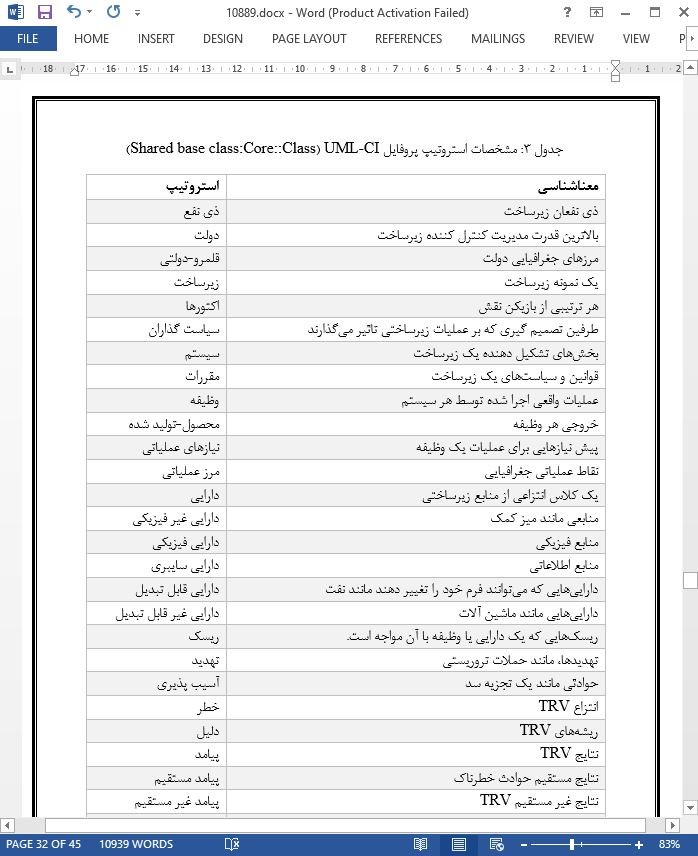
UML-CI: یک مدل مرجع برای نمایه سازی سیستم های زیرساخت های حیاتی
چکیده
مطالعه رفتار و سازمان سیستمهای زیرساختهای حیاتی توجهات گستردهای را در سالهای اخیر معطوف خود کرده است. این سیستمها تا حدی به دلیل تاثیر زیادی که بر زندگی روزمره شهروندان داشتهاند اهمیت یافتند. در این مقاله، ما مشخصههای زیرساختهای حیاتی را مطالعه میکنیم و مدل مرجعی را بر اساس زبان مدلسازی یکپارچه (UML) پیشنهاد میدهیم. این مدل مرجع، برای ارائه ابزارهای مناسب برای وظایف مدلسازی یک سیستم زیرساخت از طریق ارائه پنج متامدل اصلی تلاش میکند. ما هریک از این متامدلها را معرفی میکنیم و تشریح میکنیم که چگونه ادغام آنها در یک نمایش یکپارچه برای مشخص کردن جنبههای گوناگون یک سیستم زیرساخت امکان پذیر است. بر اساس متامدلهای UML-CI، پایگاه دانش سیستمهای زیرساختی میتواند برای کمک به روند مدلسازی، نمایه سازی و مدیریت سیستمهای زیرساختی ایجاد شود.
1. مقدمه
زیرساختهای حیاتی شبکههایی از سیستمهای مستقل، اغلب خصوصی، و ساخته شده توسط انسان هستند و توابعی را به صورت مشترک و فراگیر برای تولید و توزیع یک جریان پیوسته از خدمات و کالاهای لازم اجرا میکند (CIP-Commission 1997). این سیستمهای به شدت پیچیده میتوانند به عنوان موجودیتهای اجتماعی دسته بندی شوند که دارای مراتبی از آگاهیهای پنهان هستند. آنها میتوانند در چرخه زندگی خود سالخورده شوند و از این رو حالات عملیاتی متفاوت را تجربه کنند. "پیچیدگی" یک ویژگی ذاتی این سیستمها است که از ماهیت وظایف آنها نشات میگیرد. این سیستمهای پیچیده اغلب مسئول ارائه خدمات تخصصی به طیف گستردهای از احزاب مختلف هستند. انواع سرویسهای جمعی ارائه شده از طریق این سیستمها به حدی بزرگ است که زندگی معمولی همه شهروندان رابطه تنگاتنگی با قابلیتهای آنها دارد. از این رو تضمین میشود که ترتیبی از خدماتی که ارائه میدهند منحصربفرد، قابل اعتماد، مقرون به صرفه و به راحتی قابل دسترس باشد (Jonsson 2005).
9. نتیجه گیری و کارهای آینده
در این مقاله، یک مدل مرجع ر برای نمایه سازی و مدلسازی جنبههای متفاوت یک سیستم زیرساخت حیاتی معرفی کردیم. متاکلاسها ر این مدل مرجع در پنج متامدل سطخ بالای اصلی گروه بندی میشوند که جنبههای گوناگون رفتار و سازمان زیرساختی بررسی میشود. مهم ترین نگرانی که در این مدل مرجع بررسی شده است مسائل مدیریت و مالکیت زیرساخت حیاتی، ساختار سیستمی و سازمانی داخلی آن ها، دسته بندی دارایی و شناسایی آن؛ و نمایه سازی ریسک است.
Abstract
The study of critical infrastructure systems organization and behavior has drawn great attention in the recent years. This is in part due to their great influence on the ordinary life of every citizen. In this paper, we study critical infrastructures’ characteristics and propose a reference model based on the Unified Modeling Language (UML). This reference model attempts to provide suitable means for the task of modeling an infrastructure system through offering five major metamodels. We introduce each of these metamodels and explain how it is possible to integrate them into a unique representation to characterize various aspects of an infrastructure system. Based on the metamodels of UML-CI, infrastructure system knowledge bases can be built to aid the process of infrastructure system modeling, profiling, and management.
1 Introduction
Critical infrastructures are networks of interdependent, mostly privately-owned, man-made systems and processes that function collaboratively and synergistically to produce and distribute a continuous flow of essential goods and services (CIP-Commission 1997). These highly complex systems can be classified as sociotechnical organisms that have some sort of hidden consciousness. They can undergo aging in their lifecycle and hence experience different operational states. Complexness is an inherent property of these systems that stems from the nature of their tasks. These complex systems are mostly in charge of catering specialized services to a wide range of different parties. The type of collective services that is provided through these systems is so immense that the ordinary lives of all citizens are tightly coupled with their functionality. It is hence taken for granted that the sort of services that they provide should be ubiquitous, reliable, affordable and conveniently accessible (Jonsson 2005).
9 Conclusions and future work
In this paper, we have proposed a reference model for profiling and modeling different aspects of a critical infrastructure system. The metaclasses in this reference model are categorized in five major high-level metamodels that address various aspects of infrastructure organization and behavior. The most important concerns that have been addressed in this reference model are the issues of critical infrastructure ownership and management, their internal organization and system structure, asset classification and identification, and risk profiling.

چکیده
1. مقدمه
2. سیستمهای زیرساختهای حیاتی
2.1 وابستگیهای متقابل زیرساختها
3. مدلسازی زیرساختهای حیاتی: کارهای مربوطه
4. توسعه مدل محور
5. انگیزهها و مشوقها
6. یک مطالعه موردی واقعی
7. متامدلهای زیرساختهای حیاتی سطح بالا
7.1 متامدل مالکیت و مدیریت
7.2 متامدل ساختار و سازمان
7.3 متامدل منابع
7.4 متامدل تهدید، ریسک، آسیب پذیری (TRV)
7.5 متامدل رابطهای
8. بحث
9. نتیجه گیری و کارهای آینده
Abstract
1 Introduction
2 Critical infrastructure systems
2.1 Infrastructures’ interdependencies
3 Critical infrastructure modeling: Related work
4 Model driven development
5 Motivations and incentives
6 A real-world case study
7 High-level critical infrastructure metamodels
7.1 Ownership and management metamodel
7.2 Structure and organization metamodel
7.3 Resource metamodel
7.4 Threat, risk, vulnerability (TRV) metamodel
7.5 Relationship metamodel
8 Discussions
- ترجمه فارسی مقاله با فرمت ورد (word) با قابلیت ویرایش، بدون آرم سایت ای ترجمه
- ترجمه فارسی مقاله با فرمت pdf، بدون آرم سایت ای ترجمه
